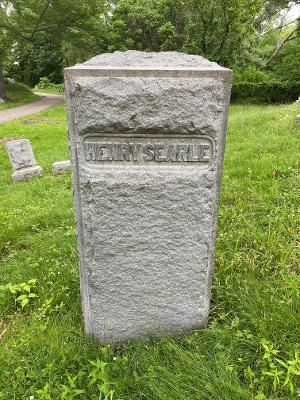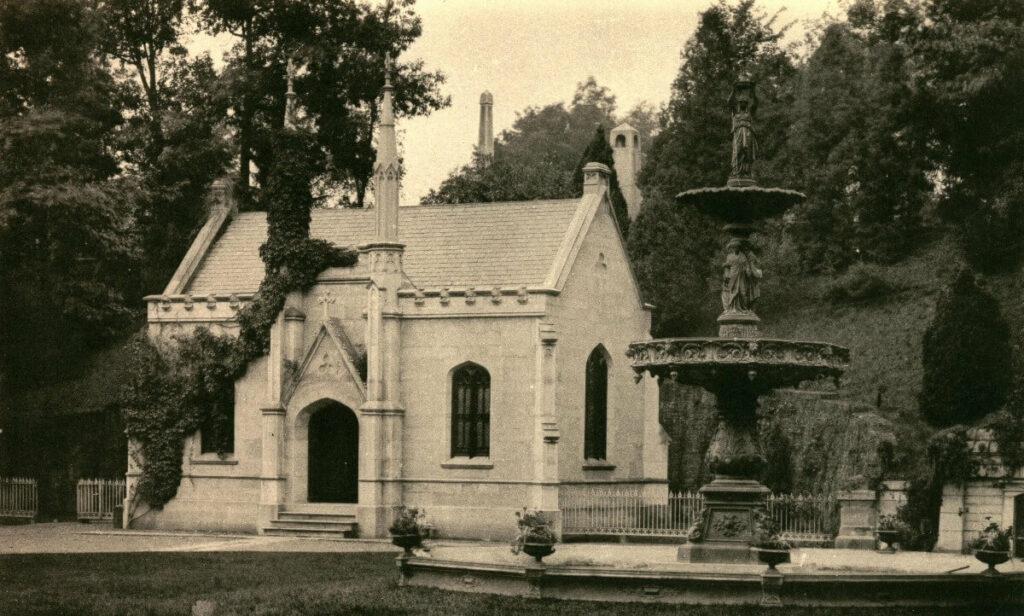Section A Vignette #9

The story of the old chapel, with its receiving vault, and of the architects, H. Searle & Son, has been little noted in late years. A pity, because both are interesting.
Contemporary Rochester newspaper accounts offer some background. A long June 20, 1861 article in the Rochester Union and Advertiser has a detailed description of the proposed Gothic structure, and tells us also that “…plans and drawings for these works were made by H. Searle & Son, architects, after a minute inspection of all the structures of this kind of any note in the country.” It goes on to postulate that “… we are to have something at Mt. Hope which will excel in everything but outlay of money, anything of the kind in the United States.”
Construction of the chapel and vault began in the spring of 1861 and was nearly finished by the end of that year. The chapel was activated in 1862 and continued in use until the 1970s. The vault, which is still intact, extends deep into the hillside beneath Indian Trail Avenue. Chapel and vault together cost $10,500 and were paid for out of the Mt. Hope fund – from the sale of lots.
Henry Searle, who began the Rochester firm which became H. Searle & Son, achieved considerable recognition during his career and is listed in national directories of American architects which have been compiled in recent times. His Rochester credits include the Monroe County Workhouse, City Hospital, Corinthian Hall, and the original 1844 two-story Rochester Savings Bank on the southwest corner of Main Street West and South Fitzhugh Street. In 1868, Henry Searle moved to Washington, D.C., where he worked in the office of the U.S. Supervising Architect.

The son, Henry Robinson Searle, left Rochester in 1865 for Washington, D.C., where he had an illustrious career. Although it was from there that he designed an 1870 third story addition to the savings bank in Rochester, most of his work concerned projects elsewhere. Among the structures he is credited with designing were buildings for the Republican newspaper and for Howard University, both in Washington. It was in this period, too, that he submitted a design for the completion of the Washington Monument which, though never adopted, brought him much acclaim within the profession and membership in the American Institute of Architects. He also joined the Philosophical Society of Washington.
In 1879, Henry Robinson Searle moved again, this time to New York City, where he remained. And it was while in New York that he gained widespread recognition as an acoustician through his development and patenting of highly original designs for the control of sound in assembly halls and other public areas. Among his commissions were the Senate Chamber at the capitol in Albany and the hall of the Union League Club in New York.
He also issued patents for processes covering the treatment of ventilation, and it seems probable that some of his insights had been incorporated in the design of the receiving vault at Mt. Hope.
Considering all of his various accomplishments, it is astonishing to learn that Henry Robinson Searle did not enjoy good health. He died in New York City on October 22,1882, at the age of only 46, a victim of tuberculosis. The New York Times obituary on the next day listed the old chapel in Mt. Hope Cemetery among his notable credits.
Henry Searle, the father, died in 1892. Both are buried in the Searle family plot at the south end of Section A in Mt. Hope.
by Jack McKinney (a founder of the Friends of Mount Hope Cemetery)
From the Epitaph, Volume 13, Number 3
Rochester, New York, Summer 1993

